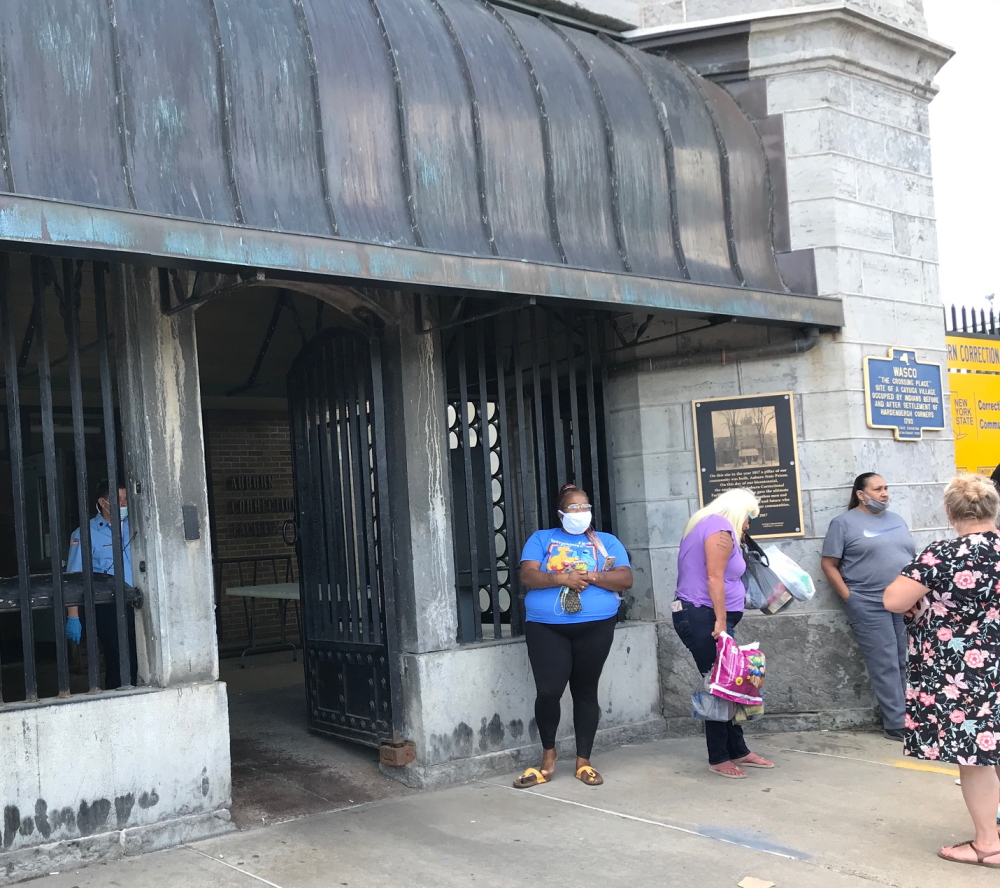AUBURN, New York — On the day she would see her father for the first time in nearly five months as he bounced among three maximum-security prisons, Julianna Bundschuh, 5, hung on the metal fence of Auburn Correctional Facility as if it were at a playground.
Near her stood Kristina Abell, who arrived first at 7 a.m. Wednesday with eight boxes of food for her son. Behind Abell was a woman named Courtney who didn’t want to give her last name. She came to see her fiance and was wondering how long these visits would last. None had seen their loved ones since mid-March, when state-run prisons across New York suspended visitation due to coronavirus.
“When you go in do they do all the bags first?” Courtney asked.
“I don’t know what the system’s gonna be this time,” Abell said. “It’s a little bit different than the last time I was here.”
Through email messages and 15- to 30-minute phone conversations, inmates caught glimpses of the uncertainty that swept across the country as New York’s most isolated facilities closed off even more: a pandemic, an economic crisis and a racial reckoning that included calls for prison reform.
 Wednesday was the first day visits were allowed in New York’s maximum-security prisons. Medium-security prisons will allow visitors on Sunday.
Wednesday was the first day visits were allowed in New York’s maximum-security prisons. Medium-security prisons will allow visitors on Sunday.
The line formed outside the prison at 7:30 a.m., where visitors waited for three-hour visits held in a visiting room to the left of the prison’s entrance. Plastic chairs separated by plastic tables kept inmates six feet apart from their visitors. Abell entered the prison at 9 a.m.
One by one, visitors shuffled into the main lobby, where they took off their belts and stuffed their belongings in lockers. Corrections officers took headshots of them. They went through metal detectors. They followed corrections officers into the visitors room, where state guidelines allow them a short hug only at the beginning and end of each visit.
“No touching, that’s strike one,” a corrections officer yelled when a woman kissed her partner. “Strike two and you’re out.”
The rules
The state rolled out a carefully hatched reopening plan that was rumored to start in July but was delayed until August. Visitors had to wear masks without logos, answer questionnaires about their out-of-state travel and have their temperature checked as they entered the visitors room.
Ebony Goode left her work shift in Syracuse, New York at 6 a.m., drove to Auburn and arrived before 9 a.m. She brought her fiancé a cheesecake as a late birthday present.
“Sometimes [the visits] is all they got,” she said. “The one thing that I don’t understand is, you know, the ones in there, yes they did [crimes] but that’s still somebody’s loved one. So stop trying to act like they’re not human.”
Goode walked into the facility at 10 and left around 1 p.m., when about a dozen visitors still waited in line.
They peered into the lobby as the end of visiting hours approached. Some had waited for four hours, but there were only 16 tables in the visiting room in order to keep to social distancing guidelines. Some visits went past the three-hour limit. No new visitors were allowed in after 2 p.m.
“We might not make it in,” said a woman who asked not to be named.
“I know,” said another woman waiting in line who didn’t want her name used.
“You spend your whole day standing here for nothing,” she said.
The line became silent around 1:30 p.m. There was a woman who had driven 2½ from Pennsylvania to see her husband. Another woman from Syracuse was waiting to see her son.
Nyasia Haylette, 28, who had driven nearly three hours from Schenectady to see her brother, stood by the entrance too. A corrections officer handed her a form around 2 p.m. with the facility’s future visit schedule.
She was one of about 10 people left waiting as visits ended.
“Man,” she said as she left. “I feel very unimportant.”
